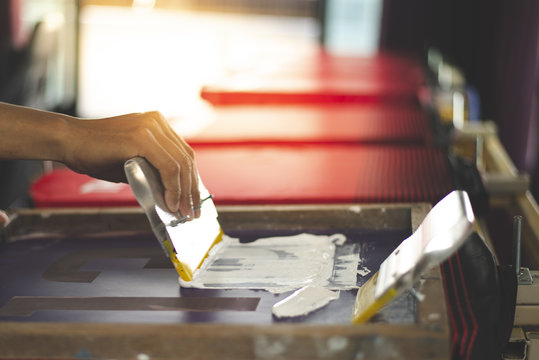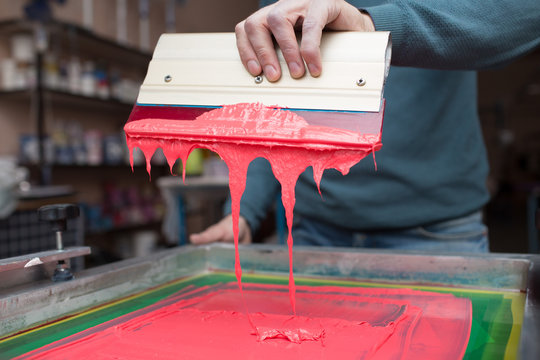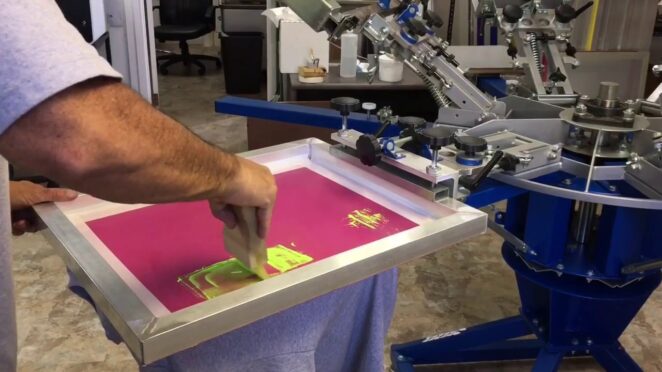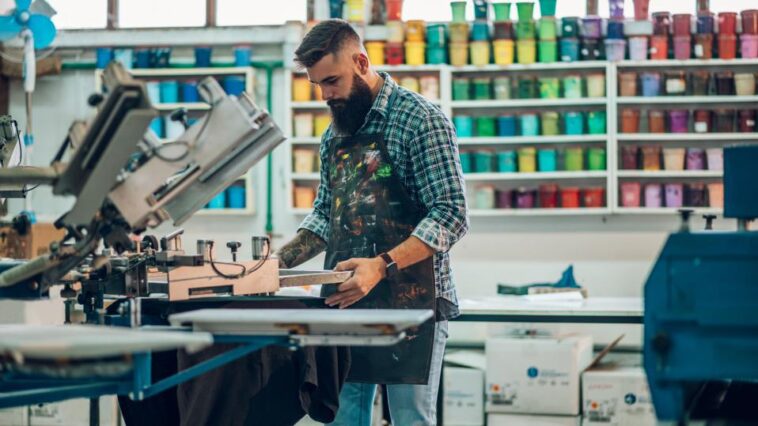It is terrifying at the same time but exhilarating when starting any new project. Screen printing is not rocket science, but people are afraid to start it as they need to figure out where to begin and fear wasting money.
Screen printing supply store helps customers buy printing essentials like different varieties of ink, reclaimers, degreasers, aerosols, wooden and metal frames, silk screen mesh, scoops, squeegees, and many other printing products.
Essentials For Screen Printing

There has always been a saying, “Success smiles upon the bravest who are willing to take chances,” Screen printing is a business project that could get started after analyzing all the risks. This business is a cost-effective solution because there is no need to buy expensive machines or increase production. As the print numbers go up, the cost reduces. A few essential materials needed to have a basic setup of this printing are.
1. Designing Software
A laptop or a desktop computer that can run the designing software for printing is enough. Depending upon the budget, both free and paid software for printing are available for designing.
2. Screen Frame
It is an essential material with a mesh where the fabric gets extended over the screen’s frame like a weave with tiny holes. It allows the emulsion to stick and, simultaneously, enables the ink to pass through the open mesh that is the stencil.
The most common size available in inches is 18”x20”, 20”x24”, and 24”x31”. If planning for an odd size to print, it is better to go for custom-sized screens.
3. Screen Printing Press
Screen printing can quickly get done with a frame and a squeegee. But even if printing just one color, the screen printing press is advised because it holds correctly.
This press holds the screen between prints without compromise, making printing easier on cloth or paper. It is easy to start with a manual one-station press as its price is low. It can get upgraded to the next level by investing in a four-station printing press that prints multi-colored prints.
4. Photo Emulsion
It is a liquid that is sensitive to light, and when exposed to UV light, it hardens and creates a stencil, which cannot get removed easily from the surface. At least a layer of emulsion gets applied to the screen.
The emulsion gets classified into different types that are water-based or plastisol ink.
5. Scoop Coater
With the help of a scoop coater, the emulsion gets applied onto the screens evenly. Sharp-edged scoop coaters are used for those mesh with higher counts, and round edges get used for lower mesh.
6. The Stencil
Stencils are like cloudy sheets that are similar to transparent sheets. With the help of a laser printer, the required designs get printed onto the stencil.
All the designs are dark colored as only this will block the UV light from the exposure unit.
7. Types Of Ink

The inks used for imprinting designs are water-based or plastisol-based ink. Since water-based ink is more environmentally friendly, it stays wet longer on the screens, and rarely chemicals get used for cleaning needs. Handling this type of ink needs technical skill.
Since technical skill is required for using water-based ink, plastisol-based ink is becoming the standard choice, as it does not need any technical skill for application.
8. Squeegee And Squeegee Holder
The squeegee is a rubber blade that is attached to a squeegee holder that is plastic, wooden, or metal. The ink gets pushed to the mesh and onto the surface that needs imprinting using the squeegee.
Many overlook this equipment, but it is vital for the printing process. Depending upon the quality, it is available in various price ranges in the market.
9. Darkroom Safe Light
For applying emulsion, a darkroom is necessary. The darkroom-safe light comes in handy while preparing the screen in the darkroom, as it helps see the things in the room.
10 Exposure Lighting
After applying emulsion to the screens, the stencil gets placed on the screen, and the design is exposed using an exposure light.
Printing On A Budget

The list is long and needs to look more budget oriented when looking at the essential materials required for printing. But there are a few tips that could cut down the cost of the materials used, and they are,
Online Websites
Many of the required screen imprinting materials could be bought online at less price when compared to the local shops. It is an excellent way to get relevant products without paying the maximum price.
Screen Frame
The price of the lumber is low, and it will be cost-effective to build the screen frame. There will be a difference in price between the self-built structure and the one bought from the local market.
Screen Printing Press
Buying a screen printing press is the expensive part of this procedure. But if tight on the budget, there is no need to buy the press.
Many small-scale printing business houses use a screen placed on a table. Pressure gets applied to it with one hand, and imprinting is done with the other using a squeegee. Place the item in the same spot when imprinting on a t-shirt or other product.
But when doing a large print, fix the frame on the table using door hinges. In this process, both hands get used when imprinting, preventing the screen from moving.
Using Ink
The cost of inks varies in price. Many online stores are available where ink gets bought at a competitive price. The other way to reduce ink consumption is by pouring less ink during imprinting. It helps in preventing the wastage of ink.
Buying Squeegee
Instead of buying a squeegee from a retailer, buy the whole kit from a wholesaler, as the price will be less.
Darkroom Lighting
When working with photo emulsion, safelight conditions are best. A darkroom safelight helps work with photo emulsion in a dark room, where it helps see everything is correct, right from mixing emulsion and applying it on the screen before exposure to UV light.
Since digital photos are trending and taking pictures using films is not widespread, many darkroom safe lights could get bought online at a competitive price.
Exposure Lighting
Buy a halogen of around five hundred or higher watt lights from the local hardware shop. After buying it, remove the wire grill and the glass from the front of this halogen light.
Since maximum UV exposure is required when exposing the artwork to the screen, this setup will act as a budget-friendly UV filter.
Conclusion
Screen printing is the most valuable skill when setting up a service to sell a t-shirt or other garment designs. There are different ways to put up decorative designs on garments. But this printing method is still dominant in the market, despite other print methods.
Other methods like dye sublimation, heat transfers, and direct-to-garment printing are reliable methods to print decorative designs on the garment, but still, many prefer screen print.
With screen printing, durable prints of high quality are possible, which last a lifetime. The colors are more flawlessly embodied, striking, and lively than any other method.
Since it is the most cost-effective solution to get started, many are still preferring it.
Single-colored print could quickly be perfected after a few good tries, whereas multi-color pattern takes time to perfection.



